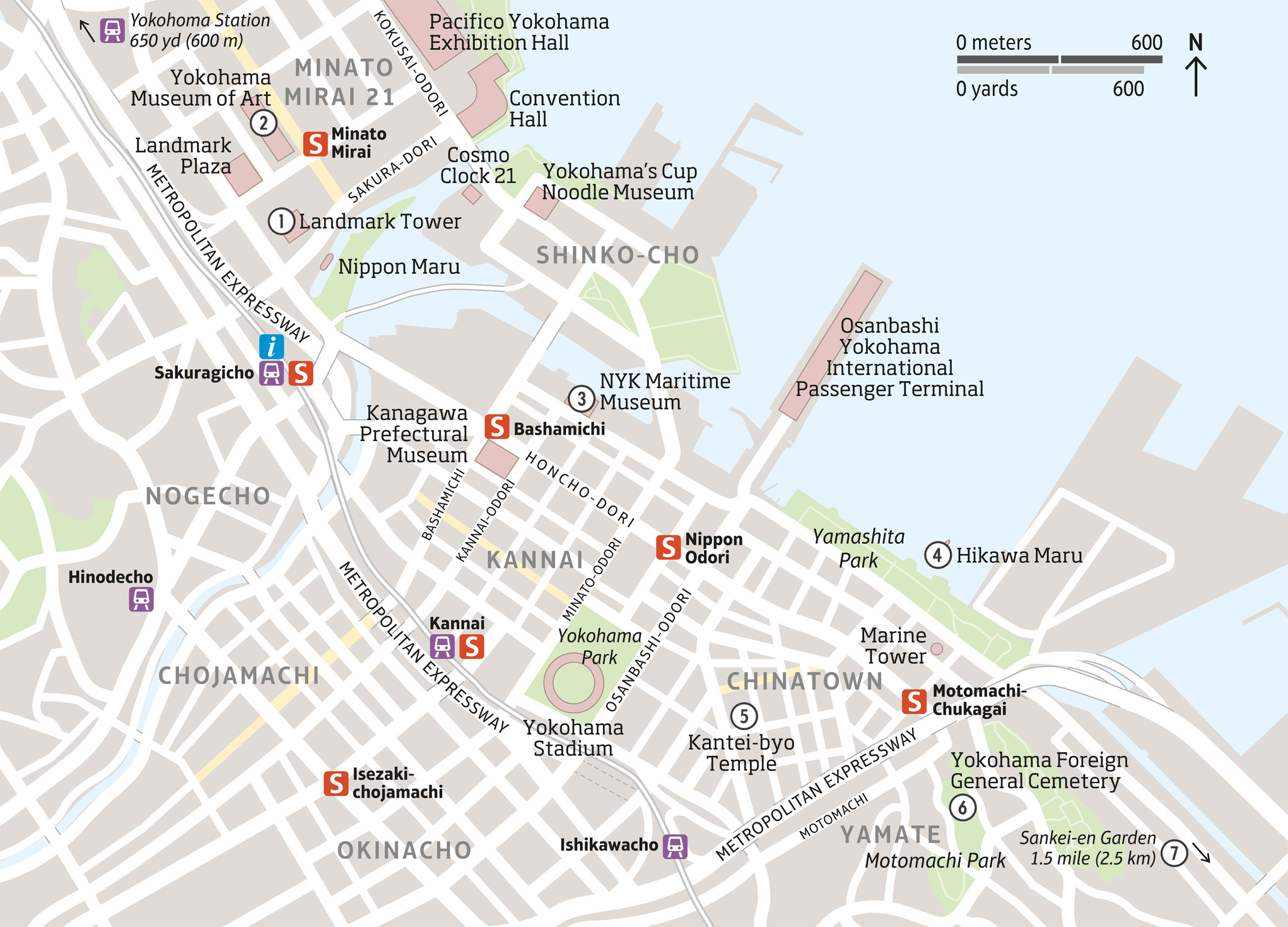g Beyond Tokyo g Contents
Japan’s second-largest city, Yokohama has been a center for shipping, trade, foreign contact, and modern ideas since the mid-19th century. Formerly a small fishing village on the Tokaido road, it was made a treaty port in 1859; there followed an influx of foreign traders, making it the biggest port in Asia by the early 1990s.

t The modern skyline of Yokohama’s Minato Mirai 21 district
Experience Beyond Tokyo

n Double-tap image to read the labels
Landmark Tower is the focal point of the futuristic Minato Mirai 21 district, an area of redeveloped docks that is particularly lively at the weekend. Built in 1993 under US architect Hugh Stubbins, the tower is Japan’s fourth-tallest structure at 971 ft (296 m). Reached by the world’s fastest elevator, traveling at 2,500 ft (750 m) per minute, the 69th-floor public lounge has a spectacular 360-degree view. Within the tower is the enormous Landmark Plaza shopping mall, which houses a numberof luxury brands, anime stores, and restaurants.
Yokohama’s role as a meeting point between East and West means that it has long been a hub for the exchange of ideas. The Yokohama Museum of Art, designed by Kenzo Tange, celebrates this legacy with its impressive collection of modern art and photography. The museum is highly engaged with Yokohama itself, and focuses on Japanese artists with connections to the city, including Imamura Shiko, Kanzan Shimomura, and Chizuko Yoshida.
Founded in the 1880s, Nippon Yusen Kaisha (NYK) is one of the world’s largest shipping companies. The quirky NYK Maritime Museum – with its exquisitely detailed model ships – celebrates the company’s history and Yokohama’s connection to the sea, showing how maritime commerce has revolutionized marine technology, trade, and politics. Visitors are also provided with a free tea ceremony.

Hidden Gem
Oodles of Noodles
True ramen obsessives should make a stop at Yokohama’s Cup Noodles Museum (www.cupnoodles-museum.jp), where visitors can fry their own ramen and design their own cup.
Originally built in 1930 as a cruise liner and light cargo ship, the Hikawa Maru spent World War II operating as a floating hospital and in its 30 years of service crossed the Pacific 254 times, carrying some 25,000 passengers. The restored liner is now permanently docked in Yokohama, where visitors can stroll the decks, inspect the elegant wood-panelled cabins and soak up the Art Deco glamour of the lounge. Those who are technically minded will enjoy the opportunity to get close to the vessel’s mighty engines.
Did You Know?
Japan’s first railroad was constructed in 1872, connecting Yokohama to Tokyo.
Few sites better evoke Yokohama’s cosmopolitan roots than Kantei-byo, the temple that has served as the heart of the city’s Chinese community – the largest in Japan – for the past 150 years. The temple is dedicated to the ancient Chinese hero Emperor Guan, who is worshiped as a deity of business. This popular temple functions as a spiritual, cultural, and social hub, and is particularly atmospheric during Chinese New Year.
Often called “Foreigners’ Cemetery”, this graveyard was founded in 1854 following the death of an American marine. Among the 4,500 tombs is that of Edmund Morel, the English engineer who helped build Japan’s first railroads.
With its ponds, bamboo groves, rivers, and meandering trails, this hideaway transports visitors back to ancient Japan. Among the garden’s architectural treasures is a 15th-century pagoda, which was constructed in Kyoto and relocated to Sankei-en in 1914.
Opened to the public in 1906, the entire garden was once the private home of Tomitaro “Sankei” Hara (1868-1939), an extremely wealthy silk merchant. His personal lodgings – a sprawling complex featuring dozens of traditional tatami rooms, overlooking a private lawn – can be toured at the site.
